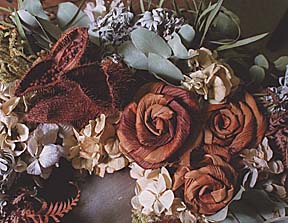


IN THE GARDEN

Ti plants are one of the many offerings
By Suzanne Tswei
at Lyon Aboretum's holiday plant sale
Special to the Star-BulletinONE of the many good things about gardening in Hawaii is that winter need not be colorless. Although we do see less color as fewer flowers come into bloom, there is always the multicolored ti leaf plant, Cordyline Fruticosa, to add some bright spots through the cooler season.
The ti plant has come a long way from the original green ti brought to the islands by the Hawaiians. The ti now comes in brilliant colors ranging in combinations of red, maroon, pink, orange, brown, yellow, purple, cream and green. When planted in groups, whether of the same variety or a mix, the colorful kahili-like heads make an eye-catching display.

Lyon Arboretum, which cultivates many different colored tis, will be selling about 50 varieties of ti plants at its annual Holiday Plant & Craft Sales Nov. 20. The plain green ti will not be among the offerings (not enough people want to buy it), nor will the purple ones (the arboretum doesn't have enough to sell.)
PLANT SALE
What: Lyon Arboretum Holiday Plant & Craft Sale
When: 9 a.m. to noon Nov. 20
Where: Lyon Arboretum, 3860 Manoa Road
Cost: Free
Parking: None at the arboretum, but a free shuttle bus will patrol Manoa Road and pick up shoppers at Manoa Elementary School, Poelua and Nipo streets
Call: 988-7378
Also for sale will be poinsettias, Native Hawaiian plants, tillandsias, orchids, herbs, dwarf mock orange, striped canna and other plants. The arboretum's volunteer group, Hui Hana Hawaii, will be selling dried wreaths, Christmas ornaments, jams and jellies, and other items. The group will be taking orders for fresh herb wreaths available in mid-December.
The ti plants for sale will be cuttings that are a few feet long -- enough to start several plants, says Bob Hirano, the arboretum's resident ti expert. You should remove almost all of the leaves before planting. Cut off the head portion and plant it as one plant. The leftover cane can be cut into 2- to 3-inch pieces with each piece as the beginning of a new plant. Or plant the uncut cane horizontally to allow new plants to emerge from the nodes.
If you live in areas that are cool and moist, you can plant the cuttings directly into the ground. Keep watch that the soil doesn't dry out while the cuttings are trying to root, Hirano says. If you live in hot and dry areas, it's best to plant the cuttings in a growing medium in pots and keep them watered but not overly wet.

"Don't put (the cutting) in water. The roots become very weak that way, and when you transfer it to soil later, the roots will have to readjust and start all over again," Hirano says.Grow the cutting in the shade and in soil with good drainage. Keep the soil moist but not so wet that the roots rot. Tis are among the easiest plants to grow and maintain, although they do not like very hot weather and strong winds (which shred the leaves.)
Once the cuttings take root, Hirano suggests planting several tis together to keep the plants looking full throughout the year. Nearly all ti plants grow straight up in single stalks, which means them eventually will look leggy and thin. Regular trimmings will solve the problem and generate more branches and fuller heads.
A colored ti that branches out on its own is Maize, one of Hirano's favorites. It has large, droopy leaves that are greenish yellow and trimmed along the edge in pink. Another of Hirano's favorites is a miniature, called Baby Spoon. Its distinguishing character is not in its grayish green color, but the way the leaves unfold to suggest the graceful shape of a pagoda, he says.
The arboretum will have these two plants for sale, as well as other sought-after varieties, such as:
Kauai Beauty, with round watermelon-pink leaves. It was the favored mother plant that gardeners used to breed other colored tis.
Hawaiian Flag, with yellow and red striped leaves.
John Cummins Miniature, with orange and green leaves.
Apple Juno, with orange and cream leaves.
Lau Kea, with green and white leaves
Orange Glow, with dark orange and cream leaves
Tachibana, a miniature with dark pink and green leaves.
Ti plants grow from about 1 to 10 feet high, and the best height depends on the variety, Hirano says. Tis are best grown in the ground but can be kept in pots with regular repotting.
If you plan to give a potted ti as gift, keep in mind that some islanders consider red tis unlucky. But red tis are shedding the negative image as people find more uses -- in leis and as perennial color accent in island gardens.
Click for online
calendars and events.